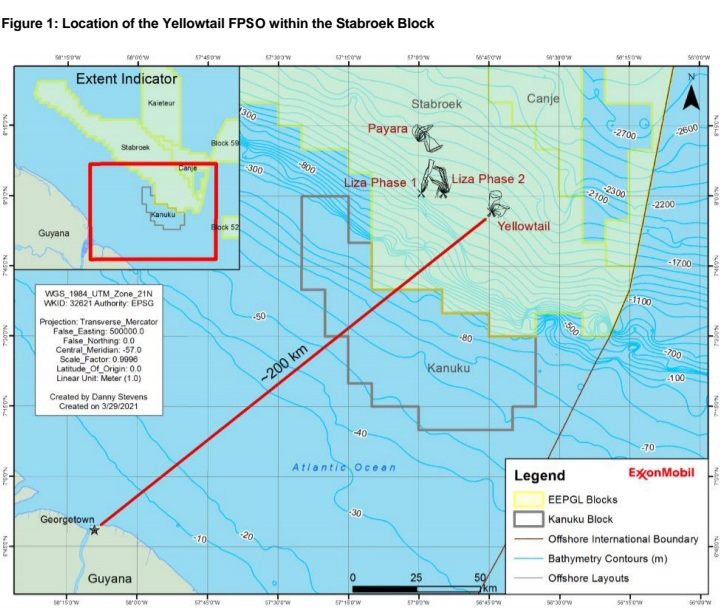As it prepares for the crafting of the Environmental Impact Assessment (EIA) for its fourth oil well here, ExxonMobil’s local affiliate has begun public consultations and scoping sessions with the public and is urging persons to share their concerns before the June 5th closure for receipt of feedback.
If approved, the Stabroek Block Yellow-tail Project will join the Liza-1 well which is in operation and the Liza-2 and Payara which are being developed.
“The questions and comments here are to help determine the terms of reference for the Yellowtail Project…the 28 days comments period ends June 5th so please send in what you want to see captured in the EIA,” Esso Exploration & Production Guyana Limited (EEPGL) local Public and Government Affairs Spokesperson Janelle Persaud told an online consultation forum on Thursday evening.
“The EIA will give you a better idea of the cumulative impact and as more studies are done it adds to that,” Project Manager Brian Schall added.
The Environmental Protection Agency (EPA) will select the entity to undertake the EIA and the public consultations are intended to help shape the areas of investigation. Even without public input the EIA is expected to address vexing issues, such as gas flaring, treatment of sea water used in oil extraction, safeguards from spillage and the impact on biodiversity and marine life. These issues have not been comprehensively addressed in earlier EIAs for Liza-1, Liza-2 and Payara though the latter did contain enhancements in the Environmental Permit that was eventually issued.
At two Zoom meetings on Thursday, ExxonMobil gave some insight into development plans for its fourth oil extraction well as it emphasized that the preservation of the environment was paramount to its operations. Given the heavy flaring from Liza-1, critics have questioned this commitment which has emanated from the oil company.
The EPA this month announced that the company has applied for an Environmen-tal Authorization to undertake the Yellowtail Development Project.
The agency said that it had determined that an EIA will have to be conducted before a decision to approve or reject the proposed project is made as it may significantly impact the environment.
As such, members of the public were invited to make written submissions to the Agency outlining questions and matters which they need to be answered or considered in the EIA. The public was given 28 days to send in those concerns and that period ends on June 5th.
At Thursday evening’s scoping meeting, businessman Vishnu Doerga told the virtual consultation meeting that he would want to know if the sizes and number of vessels offshore would have an impact on the environment.
“What is the likely impact the vessel size can have on the environment?” he asked.
Doerga and Kaieteur News Publisher, Glenn Lall were the only two persons who submitted oral questions with Lall saying that he will send in additional concerns before the June 5th deadline.
Lall asked if the flaring provisions for the Yellowtail Project will be the same as for the other three wells.
Twenty years
According to its project summary, the site will be located in the eastern portion of the Stabroek Block, 200 km from Georgetown. Oil production from the Yellowtail Development Project is expected to last at least 20 years, with approximately 45-55 wells to be drilled offshore to support extraction.
The summary, which can be found both on the EPA’s and the company’s website and Facebook page, states that the proposed project will develop the Yellowtail and Redtail fields, and other resources if such is determined to be feasible and competitive. It was stated that Yellowtail will be designed to add up to 250,000 barrels of oil per day (bpd) to existing daily production volumes in Guyana. ExxonMobil subsidiary, Esso Exploration and Production Guyana Limited (EEPGL) said that during the early stage of production operations, the Floating, Production, Storage and Offloading (FPSO) platform is anticipated to produce up to an average of approximately 6,600,000 – 7,500,000 barrels of crude oil per month. However, these estimates are preliminary and are subject to change.
The Yellowtail Project hopes to realize the projected outputs through a process that involves drilling of production wells; installation, commissioning and operations of Subsurface Umblicals, Risers and Flowlines (SURF); a FPSO; and handling and offloading of produced hydrocarbons. It will utilise marine support vessels as well as onshore infrastructure, including but not limited to shore bases, warehouses, storage and pipe yards, fabrication facilities, fuel supply facilities and waste management facilities in Guyana. These types of infrastructure will be used to support the drilling, installation, production operations, and decommissioning stages of the well.
Approximately 1,200 personnel will be employed offshore during the stage where the wells are being drilled and the offshore oil production facilities are being installed. This number will decrease to less than 200 personnel during the production operations phase. A smaller number will be utilized at the onshore support facilities.
Regarding flaring, EEPGL said that this will only occur under very unique operational circumstances and that the FPSO will use treated sea water for cooling and injection into the reservoir for additional pressure maintenance and said that the water will be discharged overboard in line with the industry’s best practices. This plan by ExxonMobil has raised concerns in the past.
The project summary stated that once approved, production is expected to begin in 2025. The FPSO will be capable of storing approximately 2 million barrels of oil. The FPSO will have living quarters and utilities needed to support operations personnel on the FPSO.
During the development of the EIA, further public consultations are expected to occur.






